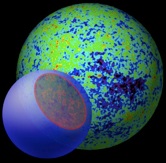
THEORETICAL COSMOLOGY:
study of the formation, nature, and evolution of the universe
My current research falls in three main categories. The first and probably largest is the study of

-
✦If inflation goes on forever, might it have been going on forever, so there is no real “beginning of time”?
-
✦What is the large-scale structure of an eternally inflating universe? What does it say about the “arrow of time?
-
✦How exactly do bubble and pocket universes form? How do transitions between different “vacua” (which describe the possible properties of these regions) occur?
-
✦If we live in such a “multiverse”, there are no unique predictions of what we should see. How, then do we test such theories or scenarios? Can this be done statistically, by determining which sorts of properties are rare versus common?
-
✦How do we make sense of quantum mechanics in a universe that is large enough that every measured quantum system necessarily has exact duplicates elsewhere?
-
✦In eternal inflation, there is an unbounded amount of time for even ultra-rare processes in which entropy decreases. What do such processes look like?
-
✦Are there possibilities for obtaining direct evidence for other pockets or bubbles?

I’ve also worked on a number of Past projects/topics, including:
-
✦The heavy-element enrichment of the intergalactic medium: Heavy elements, such as silicon, oxygen, and carbon (or “metals” is astro-parlance), are formed inside stars, which are located in galaxies. Yet, these elements are also observed in the "intergalactic medium" between galaxies.

-
✦ How much metal is out there?
-
✦ How did it get there?
-
✦ What does this process tells us about galaxy formation and evolution?
These are key unsolved problems in cosmology that may ultimately provide a "fossil record" for star and galaxy formation during the very early universe. I have tackled these questions using theory (such as computer simulations to test various ejection scenarios) and observation (analyzing quasar spectra to see how the elements are distributed outside of galaxies).
-
✦Intergalactic dust: could it be obscuring our view of the distance universe, and messing with our inferences about dark energy?
-
✦Radically different cosmologies which don’t turn out to be true, but might still be interesting: do we live in the ‘best of all possible cosmologies’? Are there other very different sets of cosmological parameters that would allow observers like us?
-
✦Black holes: what happens near black holes? What about inside them?
-
✦How to make a universe in your basement (or not)
-
✦Can modified gravity substitute for dark matter?